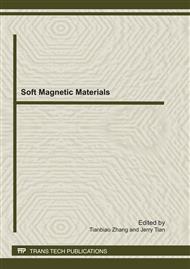p.56
p.63
p.68
p.73
p.78
p.84
p.90
p.96
p.102
DNA Electrochemical Biosensor Based on Au Nanoparticles Self-Assembled Au Electrode
Abstract:
A novel electrochemical DNA biosensor system based on Au nanoparticles (AuNPs) modified Au electrode and anthraquinone-2,6-disulfonic acid (AQDS) as hybridization indicator was presented in this paper. AuNPs with different particle sizes were prepared from gold chloride by reduction, and self-assembled on Au electrode (AuNPs/Au electrode) by cysteamine as linker. Then, 5’ end –SH modified DNA (HS-DNA) as nucleotide probes were self-assembled onto the surface of AuNPs modified Au electrode (HS-DNA/AuNPs/Au electrode), and the HS-DNA/AuNPs/Au electrode could detect target DNA (completely complementary with HS-DNA). Because AuNPs were on Au electrode, the surface of Au electrode was increased. Therefore, this would result in the increase of electrochemical signal and increase the sensitivity of biosensor. If a completely complementary single stranded DNA (ssDNA) as target existed in the detection system, the cathodic peak current (△Ip) of AuNPs modified Au electrode was increased about 3 times than the HS-DNA/AuNPs/Au electrode because of the hybridization between HS-DNA and complementary DNA target and the formation of double stranded DNA (dsDNA), and if the target was a mismatching base-pair with HS-DNA, the electrochemical signal of electrode would have no obviously change. These results showed that this DNA biosensor system based on AuNPs self-assembled Au electrode had an excellent sensitivity with a complete complementary DNA sequence.
Info:
Periodical:
Pages:
78-83
Citation:
Online since:
July 2011
Authors:
Price:
Сopyright:
© 2011 Trans Tech Publications Ltd. All Rights Reserved
Share:
Citation:


